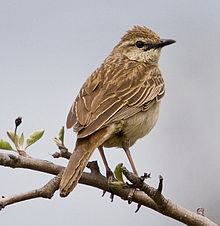Old World warblers are a large group of birds formerly grouped together in the bird family Sylviidae. They are not closely related to the New World warblers. The family held over 400 species in over 70 genera, and were the source of much taxonomic confusion. Two families were split out initially, the cisticolas into Cisticolidae and the kinglets into Regulidae. In the past ten years they have been the subject of much research and many species are now placed into other families, including the Acrocephalidae, Cettiidae, Phylloscopidae, and Megaluridae. In addition some species have been moved into existing families or have not yet had their placement fully resolved. A smaller number of warblers, together with some babblers formerly placed in the family Timaliidae and the parrotbills, are retained in a much smaller family Sylviidae.
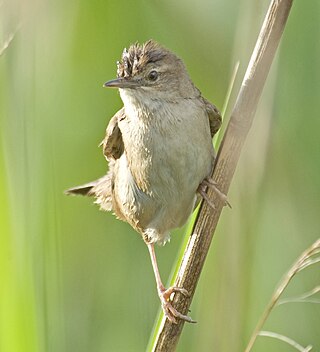
The grass warblers are small passerine birds belonging to the genus Locustella. Formerly placed in the paraphyletic "Old World warbler" assemblage, they are now considered the northernmost representatives of a largely Gondwanan family, the Locustellidae.

The bristled grassbird is a small passerine bird in the genus Schoenicola. Also known as the bristled grass warbler, this species is endemic to the Indian subcontinent, where it is patchily distributed in Bangladesh, India, Nepal and Pakistan. These insectivorous birds skulk in dense and tall grasslands, often in marshy areas, habitats that are threatened by human activities. Formerly considered to be sedentary, the species may be migratory, moving south and east in the Indian peninsula during winter and returning to their breeding grounds in the northern plains south of the Himalayas.

The brown songlark, also Australian songlark, is a small passerine bird found throughout much of Australia. A member of the family Locustellidae, this species is notable for sexual size dimorphism, among the most pronounced in any bird. It is a moderate-sized bird of nondescript plumage; the female brownish above and paler below, the larger male a darker brown.

The songlarks are a pair of species of birds in the family Locustellidae. Most taxonomists place them together with the thicketbirds in the genus Cincloramphus. They are alternatively placed in the genus Megalurus.

The New Caledonia thicketbird or New Caledonia grassbird, is a bird species. Previously placed in the "Old World warbler" family Sylviidae, it does not seem to be a close relative of the typical warblers; probably it belongs in the grass warbler family Locustellidae. This species is endemic to New Caledonia.
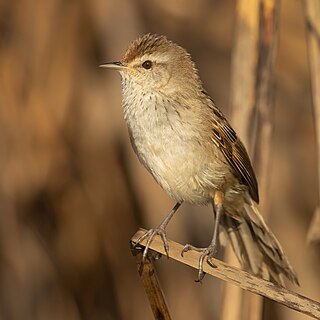
The little grassbird is a species of Old World warbler in the family Locustellidae. It is found in Australia and in West Papua, Indonesia. These sexually monomorphic birds are found in reed beds, rushes, lignum swamps and salt marshes of Southeastern Australia.

The striated grassbird is an "Old World warbler" species in the family Locustellidae. It was formerly placed in the family Sylviidae. It is now the only species placed in the genus Megalurus.
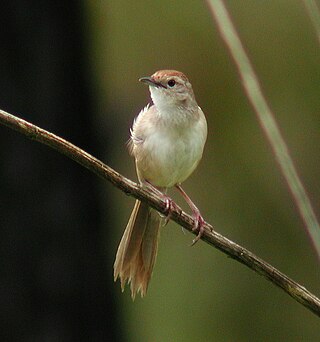
The tawny grassbird is a large songbird that is part of the grass- and bush-warbler family (Locustellidae) commonly found in grassland and reedbed habitats. It is streaked above and has a distinctive rich brown cap. Its underside is paler and it has a long graduated tail. They call often with "loud, grumpy churring calls and a longer call that starts tick-tick-tick-tick and ends with an explosive descending trill".
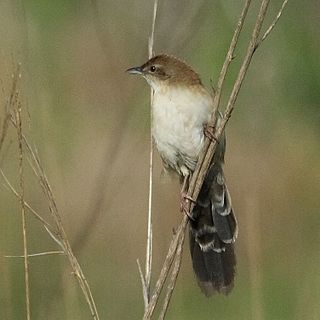
The fan-tailed grassbird or broad-tailed warbler is an African species of Old World warbler in the family Locustellidae. The species is closely related to the broad-tailed grassbird of India, and is sometimes treated as the same species, although a 2018 study found that it and the broad-tailed grassbird were not closely related, with the Indian species being a sister of Chaetornis striata.

Schoenicola is a genus of Old World warbler in the family Locustellidae. There are two species, both from peninsular India. The genus has been placed in the subfamily Megalurinae.

The broad-tailed grassbird is a species of Old World warbler in the family Locustellidae. It is endemic to the Western Ghats of India with a possibility of occurrence in Sri Lanka. A small, mostly brown bird, it has a broad rounded and graduated tail. It is found only on the higher altitude grassy hills where it usually skulks, except during the breeding season when males fly up into the air to sing in their display. The species is believed to be a resident although it is possible that they make local movements.

Locustellidae is a newly recognized family of small insectivorous songbirds ("warblers"), formerly placed in the Old World warbler "wastebin" family. It contains the grass warblers, grassbirds, and the Bradypterus "bush warblers". These birds occur mainly in Eurasia, Africa, and the Australian region. The family name is sometimes given as Megaluridae, but Locustellidae has priority.

Camarhynchus is a genus of birds in the tanager family Thraupidae. All species of Camarhynchus are endemic to the Galápagos Islands, and together with related genera, they are collectively known as Darwin's finches. Formerly classified in the bunting and American sparrow family Emberizidae, more recent molecular genetic studies have shown it to belong in the tanager family.

Argya is a genus of passerine birds in the laughingthrush family Leiothrichidae. The species are distributed across Africa and southern Asia and are typically fairly large, long-tailed birds that forage in noisy groups. Members of this genus were formerly placed in the genera Turdoides and Garrulax.

Lyncornis is a genus of eared nightjar in the family Caprimulgidae.
The Guadalcanal thicketbird is a bird species. It used to be placed in the "Old World warbler" family Sylviidae, but it does not seem to be a close relative of the typical warblers; it belongs in the grass warbler family, Locustellidae. It is found on the island of Guadalcanal in the Solomon Islands.

Helopsaltes is a genus of passerine birds in the grassbird family Locustellidae.

Poodytes is a genus of passerine birds in the grassbird family Locustellidae.

The thicketbirds are a group of birds in the family Locustellidae. Most taxonomists place them together with the songlarks in the genus Cincloramphus. They are alternatively placed in the genus Megalurus.
